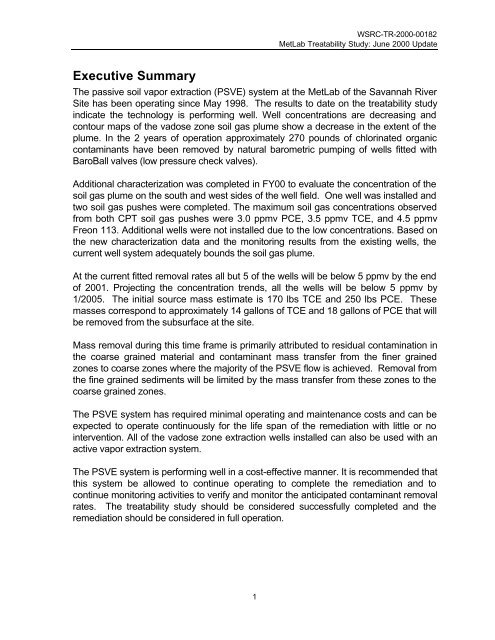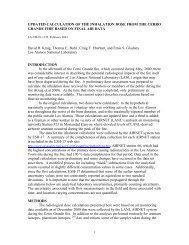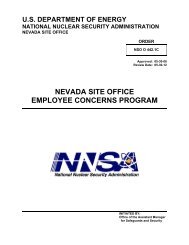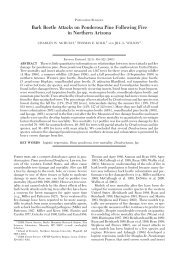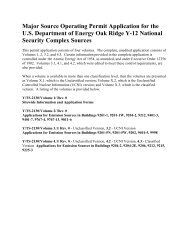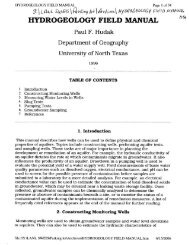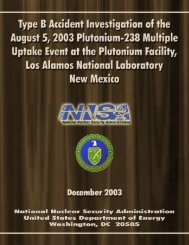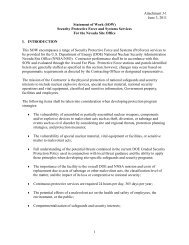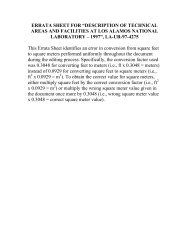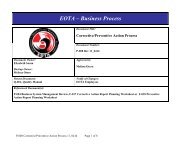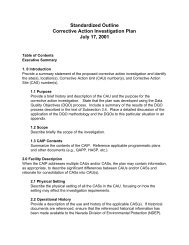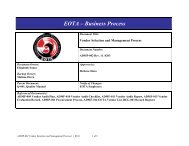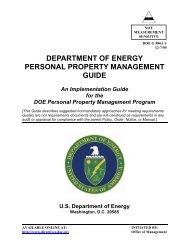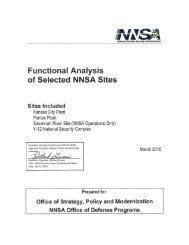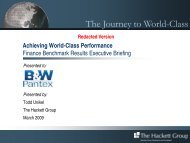An Analysis of Passive Soil Vapor Extraction Wells
An Analysis of Passive Soil Vapor Extraction Wells
An Analysis of Passive Soil Vapor Extraction Wells
Create successful ePaper yourself
Turn your PDF publications into a flip-book with our unique Google optimized e-Paper software.
WSRC-TR-2000-00182<br />
MetLab Treatability Study: June 2000 Update<br />
Executive Summary<br />
The passive soil vapor extraction (PSVE) system at the MetLab <strong>of</strong> the Savannah River<br />
Site has been operating since May 1998. The results to date on the treatability study<br />
indicate the technology is performing well. Well concentrations are decreasing and<br />
contour maps <strong>of</strong> the vadose zone soil gas plume show a decrease in the extent <strong>of</strong> the<br />
plume. In the 2 years <strong>of</strong> operation approximately 270 pounds <strong>of</strong> chlorinated organic<br />
contaminants have been removed by natural barometric pumping <strong>of</strong> wells fitted with<br />
BaroBall valves (low pressure check valves).<br />
Additional characterization was completed in FY00 to evaluate the concentration <strong>of</strong> the<br />
soil gas plume on the south and west sides <strong>of</strong> the well field. One well was installed and<br />
two soil gas pushes were completed. The maximum soil gas concentrations observed<br />
from both CPT soil gas pushes were 3.0 ppmv PCE, 3.5 ppmv TCE, and 4.5 ppmv<br />
Freon 113. Additional wells were not installed due to the low concentrations. Based on<br />
the new characterization data and the monitoring results from the existing wells, the<br />
current well system adequately bounds the soil gas plume.<br />
At the current fitted removal rates all but 5 <strong>of</strong> the wells will be below 5 ppmv by the end<br />
<strong>of</strong> 2001. Projecting the concentration trends, all the wells will be below 5 ppmv by<br />
1/2005. The initial source mass estimate is 170 lbs TCE and 250 lbs PCE. These<br />
masses correspond to approximately 14 gallons <strong>of</strong> TCE and 18 gallons <strong>of</strong> PCE that will<br />
be removed from the subsurface at the site.<br />
Mass removal during this time frame is primarily attributed to residual contamination in<br />
the coarse grained material and contaminant mass transfer from the finer grained<br />
zones to coarse zones where the majority <strong>of</strong> the PSVE flow is achieved. Removal from<br />
the fine grained sediments will be limited by the mass transfer from these zones to the<br />
coarse grained zones.<br />
The PSVE system has required minimal operating and maintenance costs and can be<br />
expected to operate continuously for the life span <strong>of</strong> the remediation with little or no<br />
intervention. All <strong>of</strong> the vadose zone extraction wells installed can also be used with an<br />
active vapor extraction system.<br />
The PSVE system is performing well in a cost-effective manner. It is recommended that<br />
this system be allowed to continue operating to complete the remediation and to<br />
continue monitoring activities to verify and monitor the anticipated contaminant removal<br />
rates. The treatability study should be considered successfully completed and the<br />
remediation should be considered in full operation.<br />
1


